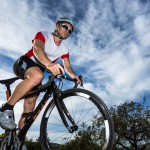Written by Daniel Quinn
With the weather getting nicer, and the longer stretch into the evenings, it’s time to get back out on the bikes and enjoy the beautiful scenery that Dublin and the surrounding areas has to offer. Cycling is a wonderful way to exercise and get away from all the noise and chaos of the city in a short space of time. The benefits of cycling are numerous from decreasing the risks of heart disease, diabetes and cancer to improving strength and increasing fitness levels. It also good for clearing the head, getting a break from our busy lives and enjoying some peace and quiet. Not forget the infectious positive mood that is spread by all the nods and smile from the other cyclist you come across.
However cycling has its risk, most of which are minor but it they do occur they can have serious consequences for the cyclist and there pastime! There are two major types of injuries when it comes to cycling; acute and overuse injuries. Acute injuries tend to happen most often on a bike when there is a crash and these consist of concussion, abrasions and fracture. These can be prevented by good cycling habits and having the right safety equipment, including helmets!
Overuse injuries are due to the constant repetitive movements that occurs when cycling for any long distances, or having to maintain static prolonged postures through the spine and upper limbs. These include:
Knee pain
Knee pain from cycling generally occurs due to patella femoral joint pain. This is when the knee is moving in the wrong pattern caused by tight and weak muscles. The pain is geneally at the front of the knee caps and is painful when you cycle. An associated pain with this is iliotibial band (ITB) dysfunction, this is due to a tight ITB that then rubs off the bones in the upper legs when you straighten your knee.
Back pain
Back pain when cycling is generally due to weak core muscle, or tight hamstrings, and a prolonger static posture when bent over a road bike or worse a tri/TT bike. The prolonger poor posture causes excessive pressures on the disc resulting in a bulge. If you are very unlucky this can pinch the nerve and cause sciatica.
Neck pain.
Neck pain is similar to back pain, but it is cause by weakness yin the trapezius muscles which help to stabilise you on a bike. Again a bulge in the disc occurs and can place extra pressure on the nerve resulting in numbness and pain in the upper limbs.
Numbness
Numbness in the upper limbs can also result from pressures on the ulnar nerve in the hand when gripping the handlebars. This can lead to permanent weakness and poor sensation in the hands if not treated.
Hip pain
Hip pain during cycling can come from a multitude of causes. Depending on where in the hip the pain occurs, it can be caused by ITB, glutes and hip flexor muscles as well as an impingement within the hip joint itself. Repetitive movements can all cause a slight irritation in these areas that increases over time.
Tendonitis
Tendonitis is an overuse injury that occurs due to too much stress being placed through a tendon for long periods. It can be caused by a tight muscle than strains the tendon until is degrades. This results in pain that progressively gets worse and beings to interfere with daily activities and cycling. Tendonitis most commonly occurs in cyclists in the patella, Achilles gluteal and elbow tendons.
In further blogs we will discuss how to prevent cycling related injuries. If you have any questions on cycling related injuries, contact Daniel Quinn on 01-491 3228.



